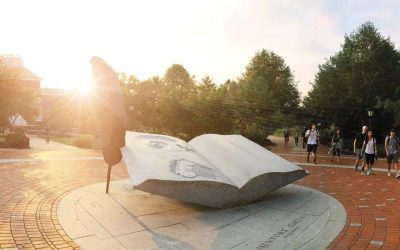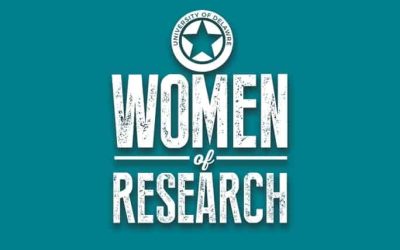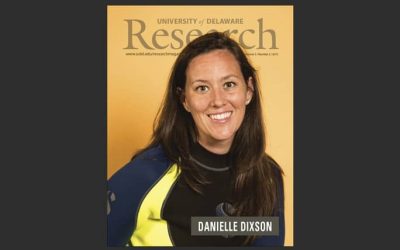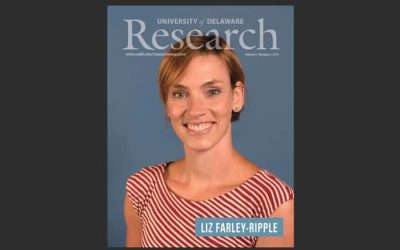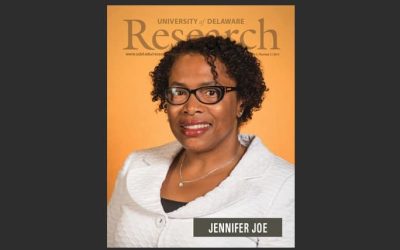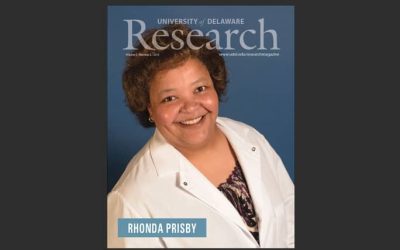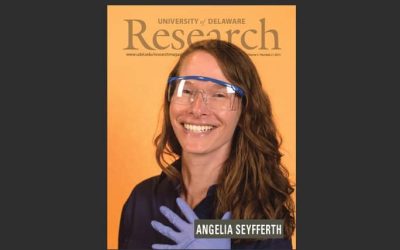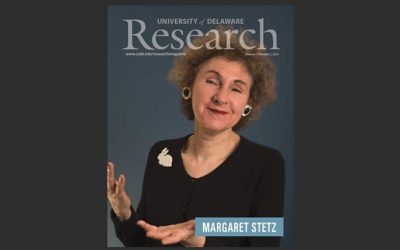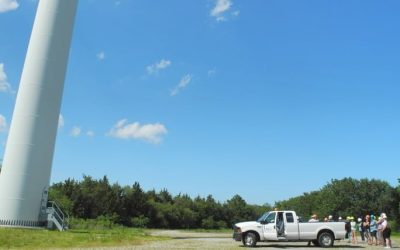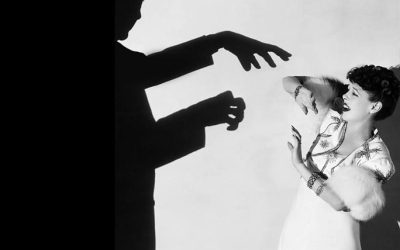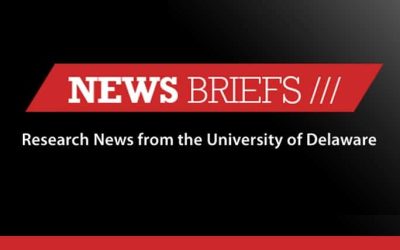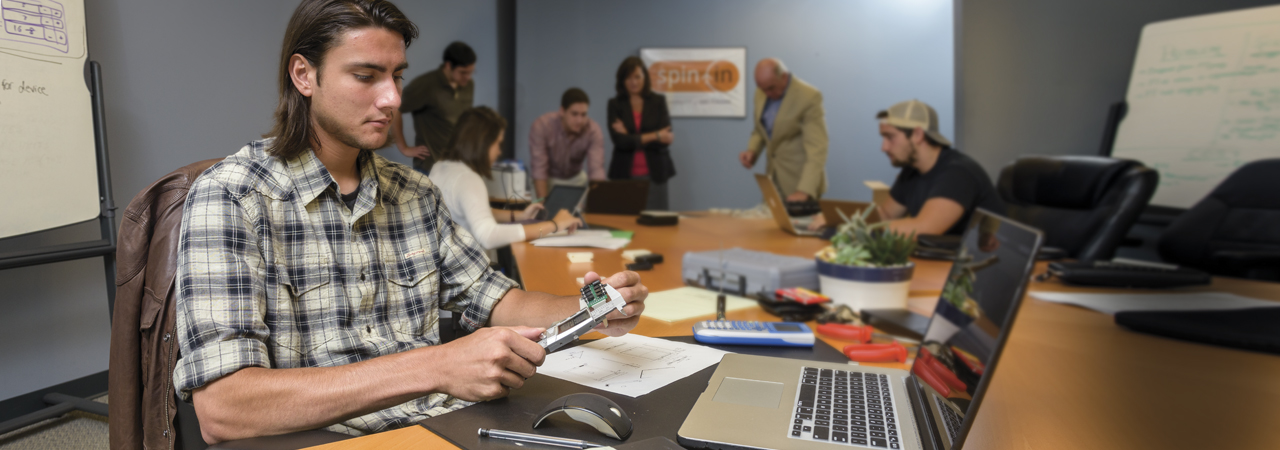
UD'S SPIN IN PROGRAM
This program gives students a chance to apply what they’re learning in real-life business challenges, helping entrepreneurs solve problems or develop new products. One of the most successful projects to date is the “mTrigger,” a biofeedback device expected to go to market by early 2016. The team, seen in its office at the Delaware Technology Park, developed, tested and continues to refine the device.

WORK IN PROGRESS: These photos show the prototypes and enhancements developed this year through UD’s Spin In program for the mTrigger, a biofeedback device. Moving chronologically from left to right, you see the first printed circuit board (PCB) model (mTrigger v0.2), meant for testing and proof of concept only. The second model adds an optimized circuit, a power LED indicator, use of a 9-volt battery and ability to plug into a phone. The third has a case, the fourth has a custom electrode cable and connector, improved case design and uses 4 AAAA batteries. The fifth has a plug and play feature and three operating modes—off, sleep and on. The present device (v1.0) has a rechargeable battery (microUSB), seven-day battery life, only turns on when plugged into a phone and a sleeker design. Now under development is a Bluetooth board to allow wireless connection and support for up to eight channels of electrodes.
Spin in spins out innovation
But this isn’t that kind of spin.
The University of Delaware’s “Spin In” program, founded, managed and trademarked by the Office of Economic Innovation and Partnerships, connects University undergraduate students with community entrepreneurs and early-stage startups to give them an inside look at business innovation in action and a chance to apply what they’re learning in real-life situations.
In turn, students have solved problems, tested ideas, built bridges and suggested new options and opportunities for research and development.
Some of their work is already going to market.
The program works this way: Problems, challenges and what-ifs come in the door, occupy the radar screens of students with expertise in engineering, science, marketing, graphic design, public policy and communication, and go through weeks of analysis, brainstorming, debate, reality checks, engineering options, testing, market checks, revisions, field tests, refinements, adjustments, calibrations—whatever these idea-collider-accelerator teams find necessary.
At the end of the conveyor belt, undergraduate students come away with a far greater understanding of business demands and the experience of collaborating on work that matters. The entrepreneurs may come away with an upgraded product, a new process, a fresh marketing approach—maybe even new employees.
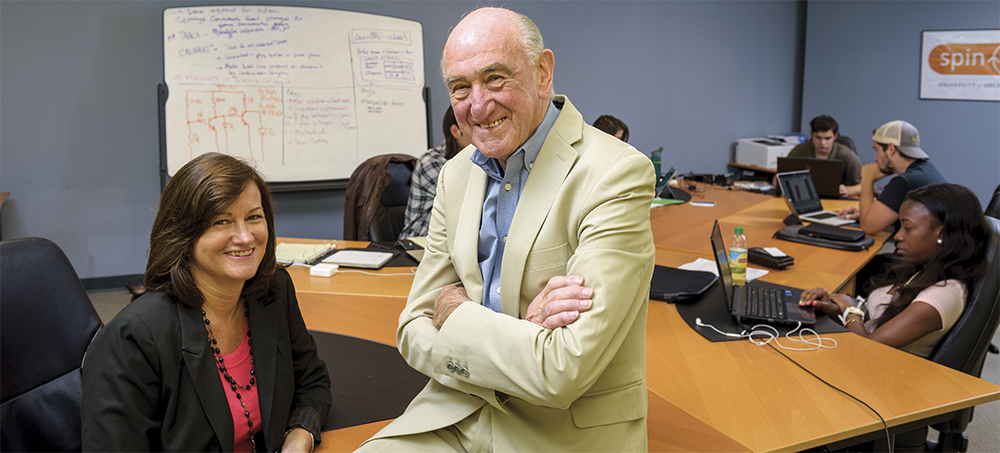
David Weir and Cyndi McLaughlin, who direct UD’s Office of Economic Innovation and Partnerships, launched the Spin In program to give students opportunities to work with entrepreneurs.
“Students begin to understand what it means to be an entrepreneur,” said David Weir, director of OEIP. “Some say, ‘That’s what I want to be.’ Others see it, understand it, but say ‘I want to be part of a big company.’”
The Spin In program was built with undergraduate students in mind—a way to expand their expertise and insight at a critical point in their careers and give them a competitive advantage. The obvious benefit to business owners was an added value that now is increasing the demand for more partnerships.
“We came out with bonus points,” said Cyndi McLaughlin, assistant director. “We came out with entrepreneurs who are really excited. So we were able to meet two needs, not just one.”
Fourteen projects have spun into this fascinating machine so far. Ten are complete, four are ongoing or on the drawing board, and six students have been gobbled up for employment—including one who soon may be the CEO of a startup.
The biggest challenge now for OEIP is how to scale this recipe to meet an increasing demand without smothering its unique innovative spice.
“You have to pick the right project and the right entrepreneur,” said Weir. “It’s an educational experience with a strong entrepreneurial flavor—and we don’t want to lose that.”
OEIP soon will gain a bit more room to expand the work and its reach as resources become available. The program will have space in the incubator section of the University’s new STAR Campus next year. Teams will have about 500 square feet to spread out their 3-D printers and laptops. They will be adjacent to start-up labs and have access to wet lab space.
A proposed partnership with Delaware Technical Community College could open other doors, giving students access to its manufacturing and engineering capabilities.
Weir and McLaughlin have helped students and business owners connect well with each other. They have put guardrails in place to be sure no one goes down in flames.
The project can’t be “business critical,” Weir said, nothing that—if it failed—would cripple the business. And business owners and students have to be realistic. Not everything works. Interruptions happen. Timing can go wrong.
“The thing that’s difficult is managing expectations,” said Weir, a chemical physicist who spent 35 years with the DuPont Co. before joining the University in 1998. “Students have learned a lot. But the value of time is viewed differently. The entrepreneur doesn’t have the luxury of spending too much time reaching decisions. So the challenge is the value of time and the requirement for bringing the disciplines together quickly.”
Another challenge lies in the interdisciplinary dynamic at work within the student teams. For many, it is their first endeavor with those trained in other fields, and crossing over is not always smooth.
Engineers have much different habits of mind than artists and marketing students, for example. Computer scientists look at problems from a different perspective than public policy specialists.
Those encounters are sometimes frustrating, sometimes fascinating—but always important to the final product.
That was clear to Adam Engelson, an electrical engineering major, who is part of one of the most successful projects to date. His team developed a biofeedback device known as “mTrigger” for a medical equipment company. It is expected to go to market in early 2016, Weir said.
“In the beginning it was challenging to collaborate with such different people,” Engelson said. “You have electrical engineers and political science majors and you learn how to work together. I learn some social policy, you learn some engineering. On the mTrigger project, we learn to work together with graphic designers, biomedical engineers and business analysts while getting exposed to the whole product life cycle.”
Even those with expertise in communication are stretched in these conversations.
“We think very creatively, and they’re very analytical,” said Amanda Smith, a mass communication major who worked with engineering students in an experimental class developed by Lindsay Hoffman, associate professor of communication and political science, that used an adapted Spin In approach. “It’s hard to get your ideas across in ways they understand and vice versa.”
Andrew Seski, a finance and business management major, was on a team that addressed a request from Nancy Gregory of UD’s Cooperative Extension Service. Could they develop a mobile application to help Delaware farmers?
They could and they did.
“Four weeks ago five strangers met in a room with a simple request,” he said, when his team presented its work at a Spin In event last spring. They emerged with “PocketFarmer,” an app designed to help Christmas tree growers identify problems and stop diseases that could damage their trees and their business.
“We narrowed it down to conifers—to the diseases and disorders those trees get,” Gregory said. The application offers descriptions of problems, pests and other threats in a format farmers can use in the field. “But it is generic enough to expand.”
Nate Smith, a plant and soil science major, was part of the PocketFarmer team.
“It was an interesting and good experience to work with everybody from different majors and cultures,” he said. “To bring them all together in one room—it’s one of those things you never have. I was just taking all these plant classes.”
This gave him many new contacts, he said, and broadened his understanding of the business and engineering considerations of such efforts.
Several teams continued their work through the summer. Typically, they collaborate for at least 15 hours each week, McLaughlin said, and work on research, coding, design and other tasks the rest of the time.
“I could have worked for a bank this summer, but this offered serious hands-on engineering work and in our line of work that is super important,” said Brett Smith, a senior electrical engineering major who joined the mTrigger project a few months ago. “You might work for an established company only to have your project shelved after six months of work. With this, you’re contributing to something that will be put to use right away.”
Myla Lyles of Middletown joined the project this summer. She is a senior exercise science major at Wesley College and was immediately drawn to the challenge.
“My part is to give correct placement of the electrodes,” she said. She gets that—she’s trained in that. The rest of the collaboration is new territory.
“This is a new experience for me,” she said. “I have never been part of something we were all building.”
Jordan Burchfield, who graduated this spring from Delaware Tech, also is on the mTrigger team. He plans to attend UD and major in mechanical engineering.
That team illustrates the reach the Spin In program offers—drawing in students from multiple disciplines, from beyond UD, and offering all involved the chance to apply their skill and expertise in practical ways to solve problems, learn from each other and see what spins out.
In coming months, OEIP has been invited to present the concept at a national meeting of EPSCoR and a regional meeting of the National Institutes of Health’s IDeA Network of Biomedical Research Excellence Program (INBRE). It is building an entrepreneurial community and is developing additional entry points for students. Spin In soon will be part of the University’s cohort program in innovation and entrepreneurship.
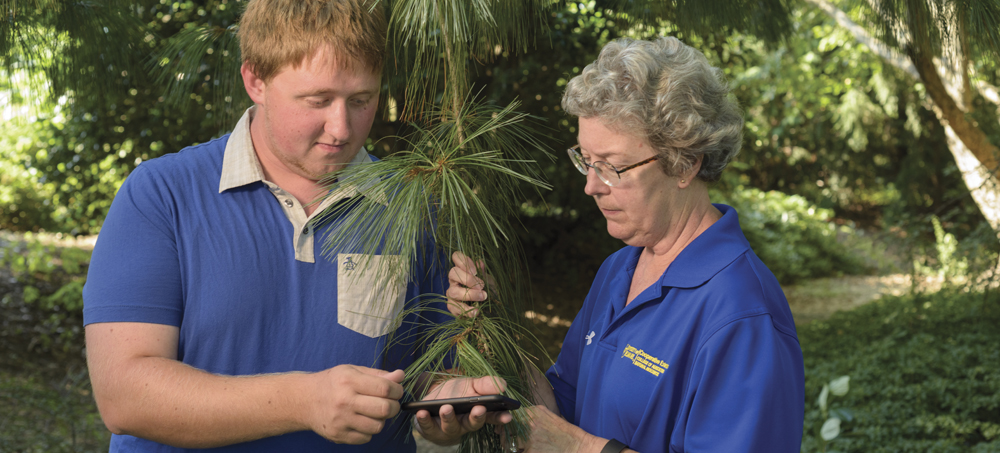
Nate Smith, left, was part of the Spin In team that created PocketFarmer, a smartphone application, in response to a request from Nancy Gregory, right, of UD’s Cooperative Extension Service.
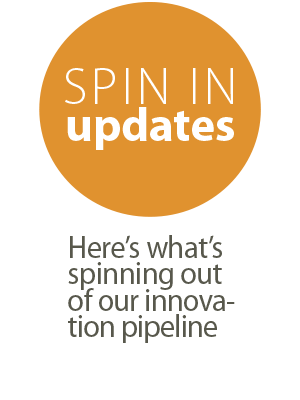
5Roads
Website and app in use by entrepreneurial service that links volunteers with non-profit agencies.
Connect Hub
Web-based learning platform for training and coaching, with iOS and Android versions. Continued platform and mobile application development, marketing campaign to be completed fall 2015.
Esper
Device to separate perchlorate from water, designed by UD faculty member. Spin In team did market and policy research, customer discovery, built a second-generation prototype. Marketability under review.
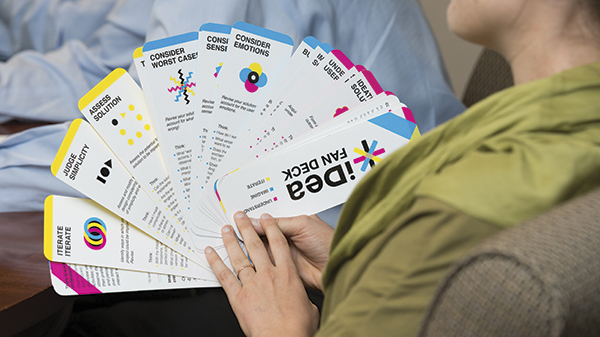
Fan Deck
Design thinking and leadership tool available on iTunes. Translated into Chinese last spring. Used in UD classes and private sector workshops by inventors Tony Middlebrooks and Jules Bruck.
Linne Industries
Solar pond aeration system in market nationally and internationally through Pond Hawk. Recently awarded Center for Advanced Technology grant from Delaware Biotechnology Institute.
mTrigger
Biofeedback device. Company will be incorporated fall 2015. Potential product launch January 2016. Continued business development and development of Bluetooth version for fall semester.
Pocket Farmer
Mobile application offering information and diagnosis on health of conifers for growers. Beta testing continues.
SimuCare
Five simulation training products for health care industry (in partnership with Mechanical Engineering Senior Design). Beta testing underway, start-up viability being evaluated. Second-generation prototypes in development.
QR Code
Basic research for a pilot study on the use of image-embedded QR codes at UD. Pilot study, business planning and app development during fall 2015.
Quad Crew
Adaptive crew boat for adults with physical disabilities, in partnership with Mechanical Engineering Senior Design. Research continues and WinTech manufacturing has expressed interest in partnership for development.
NEW THIS FALL
The Tree Butler: Business and prototype development for a new design for tree support systems.
Packet Protein: Business and product development for a new company based on protein powder.
MORE STORIES
ADVANCE-ing UD
Seven faculty members are highlighted in this issue of UD Research. Indeed, there are commonalities among them—a steadfast commitment to excellence, unrelenting intellectual curiosity, mentors and role models who inspire, and a disdain for the status quo. I encourage you to read their stories to learn about their inspirations, the challenges they have faced and the scope and quality of their scholarly endeavors.
Women of Research
Extraordinary research is underway at the University of Delaware, and women are all over it. We profile seven researchers who offer insight into their work—from coral reefs to corporations—what hurdles they have cleared and what keeps them moving forward.
Danielle Dixson
A chance encounter with a tour guide at the Shedd Aquarium in Chicago is what sparked Minnesota native Danielle Dixson’s interest in marine biology. “I was 5 years old and the guide gave me a book for asking a clever question about whales,” she says.
Liz Farley-Ripple
Elizabeth Farley-Ripple did not set out to become an education researcher. As an undergraduate at Georgetown University, she started out majoring in Latin American Studies. Then came Professor Bill McDonald’s sociology course focusing on research methods. “I had an aha moment,” says Farley-Ripple. “I realized I could have an impact—and actually apply the ideas I had been reading about.”
Jennifer Joe
Jennifer Joe, the Whitney Family Professor of Accounting in the Alfred Lerner College of Business and Economics, attributes positive experiences with her professors in college as the impetus for her pursuit of an academic career.
Rhonda Prisby
Rhonda Prisby had a plan for her master’s degree in exercise physiology. She expected to work in a cardiac rehabilitation clinic. Then a professor mentioned something she hadn’t considered—her potential as a researcher.
Angelia Seyfferth
Having had the chance to conduct research taking water samples on the Chesapeake Bay early in her undergraduate studies, Angelia Seyfferth, assistant professor in the Department of Plant and Soil Sciences, is hoping to pass her enthusiasm for research to young scholars in her lab.
Margaret Stetz
As a scholar with diverse interests from 19th-century British literature to military history and fashion studies, and who shares her work in a variety of academic and community forums, Margaret D. Stetz might be expected to have difficulty summarizing what she does.
Cathy Wu
For Cathy Wu, becoming a bioinformatics expert was kind of accidental. Armed with a Ph.D. in plant pathology and a postdoc in molecular biology, she followed her husband on a job move to Tyler, Texas, in the mid-1980s, but was unable to land a good faculty position there.
Never underestimate the power of good mentoring
A few years ago, a newly hired female faculty member had the following experience: A male colleague responded to her hallway greeting by saying hello and adding, “I hope everyone is making you feel welcome.”
Making it clear
For the past three years, almost 90 educators from around Delaware and Maryland have been working with scientists and environmental experts from the University of Delaware and the University of Maryland. The goal is to develop a richer understanding of climate change and build effective activities and instruction plans to help their students understand the data and find potential solutions.
Solar Strong
The vast majority of the sun’s extraordinary power remains out of reach—absorbed, deflected or otherwise inaccessible to today’s power-hungry masses—but University of Delaware researchers continue their quest to capture more, store more and deploy it more efficiently.
Slaves’ lives emerge from ancient ruins
“Detfri slave of Herennius Sattius” and “Amica slave of Herennius” reads the terra-cotta tile. It was discovered atop the ancient temple in Pietrabbondante, a town tucked into the bare rock and evergreen-covered mountains more than 100 miles east of Rome.
Honors
• Dugan named Truman Scholar
• Overby elected to board of Oak Ridge consortium
• Backbone of the profession
Fearsome Fridays
Tom Fernsler, “Dr. 13,” now retired from the Delaware Center for Teacher Education, knows a lot about Friday the 13th. Do you? Take our quiz and find out!
News Briefs
• Changing the color of light
• What’s it really mean if a CEO is greedy?
• Research All-Stars field new findings




